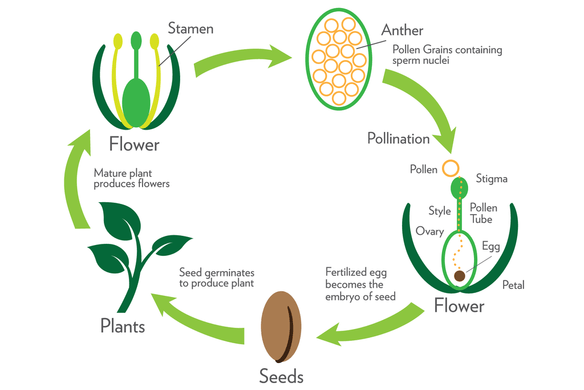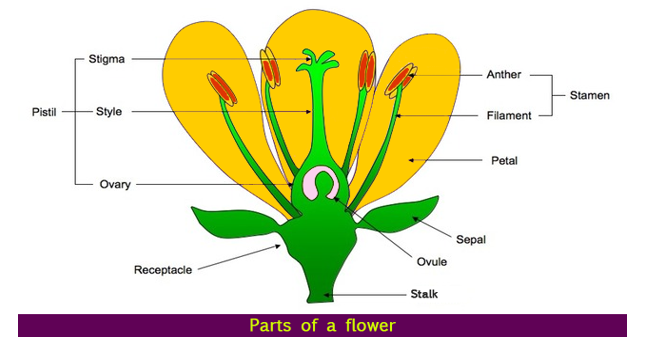Back to: BIOLOGY SS2
Welcome to Class !!
We are eager to have you join us !!
In today’s Biology class, We will be learning about Reproduction in Plants. We hope you enjoy the class!

CONTENT
- Structures and Functions of the Reproductive Organs in Plants
- Arrangement of Reproductive Organs in Plants
- Types of Flowers
- Kinds of Placentations
STRUCTURES AND FUNCTIONS OF THE REPRODUCTIVE ORGANS IN PLANTS
The flower is the reproductive structure of a flowering plant. It has both male and female sex organs hence it can carry out sexual reproduction. After fertilization has taken place in flowers, seeds are produced.
A flower has two major parts:
- The floral part (whorls)
- The flower stalk (pedicel).
The floral part of the flower is formed by
- calyx (sepals)
- Corolla (petals)
- androecium (stamens)
- gynoecium (carpels)

PARTS OF A TYPICAL FLOWER
THE CALYX
The calyx consists of sepals which are usually small and green. They protect the flower present in the bud. Sepals are usually up to 3-5 in numbers and they may be separated (polysepalous) or joined to form a cup (gamosepalous). Epicalyx may be present e.g. in hibiscus flower.
THE COROLLA
The corolla consists of petals inside the sepals. Petals are the attractive part of a flower and could be up to 4-10 and maybe separated (polypetalous) or joined to form a tube (gamopetalous). They are generally coloured and scented to attract pollinators (e.g. insects)
THE ANDROECIUM
The androecium is the male reproductive organs of a flower. It is a group of stamens which consist of two parts –the filament and anthers. Stamens could be up to 3 or more (free or joined together). The anther is a 2-4 lobed structure producing the pollen grains (fine yellowish particles) which in turn produce the male gamete in flowers. At maturity, the anther lobes open to release the pollen grains.
THE GYNOECIUM
The gynoecium is the female reproductive organ of a flower. It is the innermost floral part of the flower. The gynoecium consists of carpels which may be one or many. Carpels may be separate (monocarpous) e.g. flamboyant or may be fused (polycarpous) e.g. hibiscus. A Pistil or carpel consists of three parts, they are ovary, style and stigma.
The ovary contains ovule which produces the female gamete. After fertilization, the ovary develops into the fruit while the ovule develops into a seed.
TYPES OF OVARY
- Superior Ovary- when it is above other floral parts and such flower is called hypogynous flower e.g. hibiscus
- Inferior Ovary- when it is below other floral parts such flower is referred to as epigynous flower e.g. sunflower.
- Half inferior Ovary- when the ovary is at the same level as other floral parts, such is called perigynous ovary e.g. rose flower.

EVALUATION
- Describe the male reproductive parts of a flowering plant.
- Explain the different types of the ovary.
TYPES OF FLOWER
Generally, flowers defer in the following
- number of floral parts
- colour of petals
- size and shape
- symmetry
Flowers can be radially symmetrical/regular (actinomorphic) or irregular (zygomorphic).
- A complete or perfect flower, when all the four floral parts are present, or imperfect or incomplete flower if one or more of the floral parts are absent.
- Position of the ovary (hypogynous, epigynous or perigynous flowers).
- If flowers occur singly (solitary flower) or in a group (inflorescence).
- If flowers are born in axils of leaves (axillary) or at the end of the stem or branches (terminal flowers).
EVALUATION
- Classify flowers based on a) number of floral parts b) position of the ovary
- List the factors to consider when classifying flowers.
SEXES IN PLANTS
Most flowers are bisexual i.e. they have both stamens and carpels while a few are unisexual (either male or female). Therefore, a plant can be monoecious (when both male and female flower occurs on the same plant e. g. maize or dioecious (when male and female flower are found on different plant e. g. pawpaw.
PLACENTATION
This is defined as the arrangement of the ovules within the ovary of a flower. The ovules are attached to the ovary by fleshy structures called placenta through short stalks called funicles.
TYPES OF PLACENTATION;
- Marginal placentation: Ovule is arranged at the margin of the ovaries e.g. beans, flamboyant flowers
- Parietal placentation: Ovules are arranged to the side of the ovary or within a single chamber or cavity e.g. pawpaw.
- Free central placentation: Ovules are born on a knob projecting from the base of the ovary e. g. water lily.
- Axile placentation: Carpels meet at the centre to form the placenta for attachment of ovules e.g. tomatoes
- Basal placentation: Ovules are attached to the base of ovule e. g. sunflower.

GENERAL EVALUATION
- With a well-labelled diagram describe the structural makeup of a flower.
- With an example each state and explain the types of the ovary.
- List the four floral parts of a flower and their functions.
- Classify flower based on sexes.
- What is placentation?
- Describe five types of placentation and give one example in each case.
READING ASSIGNMENT
College Biology, chapter 16, pages 305-324
WEEKEND ASSIGNMENT
SECTION A
- The reproduction structural part of the flower include the following except A. corolla B. androecium C. gynoecium D. stigma
- A flower having both male and female flowers on the same plant is referred to as A. monoecious flower B. dioecious flower C. hypogynous flower D. axillary flower.
- An example of flower possessing half inferior ovary is A. hibiscus B. sunflower C. rose flower D. flamboyant
- The arrangement of ovules in the ovaries is referred to as A. pollination B. placentation C. fertilization D. solitary
- An example of axile placentation is found in A. sunflower B. lily C. pawpaw D. tomato
SECTION B
- With the aid of diagrams, distinguish between a monocarpous ovary and a syncarpous ovary.
- Describe five types of placentation and give one example in each case.
We have come to the end of this class. We do hope you enjoyed the class?
Should you have any further question, feel free to ask in the comment section below and trust us to respond as soon as possible.
In our next class, we will be learning about Pollination. We are very much eager to meet you there.

Good day. please is it possible to copy the above note on reproduction in plants?